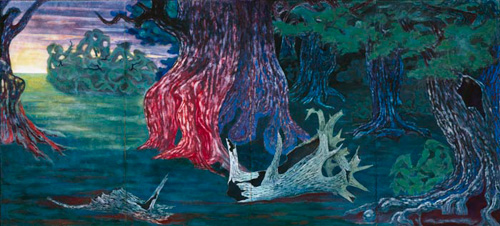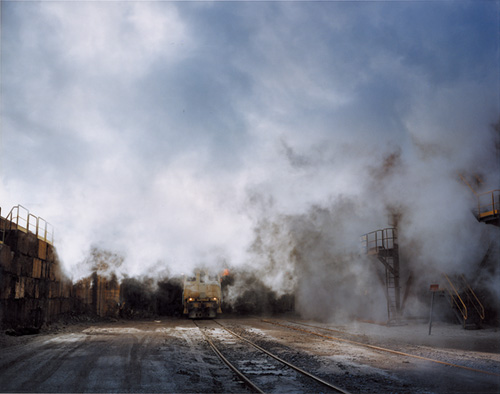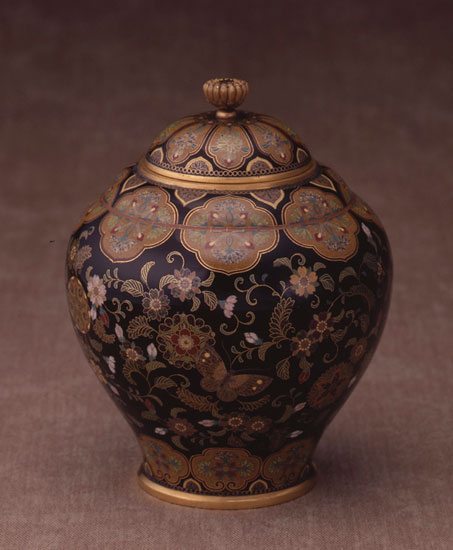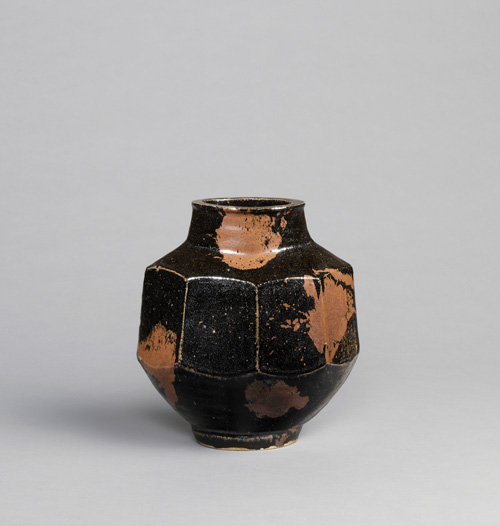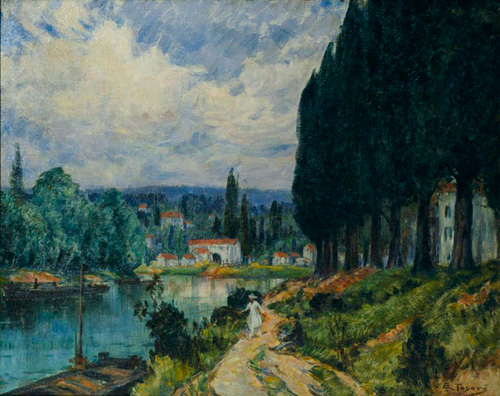
Collection Gallery
3rd Collection Gallery Exhibition 2020–2021
2020.10.08 thu. - 12.20 sun.
Selected Works of Western Modern Art
In this area we present outstanding works of Western modern art belonging or deposited to the museum. Currently, we are pleased to exhibit the work of Johannes Itten (1888-1967), the Swiss painter, art theorist, and educator, in conjunction with the Moriguchi Kunihiko: Yuzen / Design – Crossroads of Creativity exhibition concurrently on view.
Moriguchi Kunihiko studied under Jean Widmer as an international student at École nationale supérieure des Arts Décoratifs (ENSAD) in Paris. Originally from Switzerland, Widmer is known as the first to introduce Bauhaus-influenced graphic design studies to ENSAD. Widmer studied at the School of Applied Arts in Zurich in the late 1940s when the school’s director was Johannes Itten, who had taught at the Bauhaus from school’s foundation in 1919 until 1923 and was instrumental in developing its Preliminary Course. After leaving the Bauhaus, Itten remained involved in art education and the study and practice of color theory in Berlin and Krefeld, and in Zurich after the war, while producing works of art. Notably, his chromatic theory was set forth in the 1961 book The Art of Color, which was translated into many languages and continues to exert a powerful influence on art and design education around the world.
Johannes Itten, 10 Original Lithographs is a collection of lithographs produced just before Itten began teaching at the Bauhaus, of which two feature landscapes and flowers, four depict the human body, and four are abstract compositions. At this time, believing that “a picture is not a static structure but a field of visual possibilities and movements of the gaze,” Itten was searching for means of representing “moments in time and impressions of limitless dynamism.” In these works, Itten approaches this through vigorous brushstrokes and overlapping spiral forms.
In contrast to his single-color prints, his late oil painting Happy Island Town makes a powerful impression with its vivid palette. While writing The Art of Color beginning in the late 1950s, Itten produced numerous geometric abstractions. His concern was with bringing analysis of color contrasts and compositional integration into decisive harmony, and to this end he examined the functioning and cognitive potential of colors from many different perspectives. In this work he represents a view of an island surrounded by water, which is encircled in turn by greenery, using squares of various colors. The rhythmic arrangement of contrasting colors, ranging from red at the warmest to cool blues and greens, increases in warmth from the periphery toward to center, evoking a rising sensation of joy in the viewer.
The results of Itten’s lifelong exploration of methods of creating dynamism and harmony in works of art, using basic visual elements such as line and color, had a definite influence via Widmer on Moriguchi’s approach to his own art.
On the Dissolution of the Pan Real Art Association YAMAZAKI Takashi, Forest, 1949
As it happens, the museum was planning to present a special exhibit entitled From the Rekitei Bijutsu Kyokai (Rekitei Art Association) to Pan Real and the Pan Real Art Association for our second exhibition this fiscal year. However, it was put on hold during a temporary closure due to the COVID-19 pandemic, and subsequently when drawing up our revised schedule we learned that the Pan Real Art Association had been disbanded in April of this year. For this reason we have altered the originally planned content, and will focus on the period after the Pan Real Art Association was formed.
The Pan Real Art Association was founded in 1949 when ceramists and oil painters left the group known as Pan Real, formed the previous year, leaving a membership consisting entirely of Nihonga (modern Japanese-style) painters. The members at the time of establishment were Yamazaki Takashi, Mikami Makoto, Hoshino Shingo, Tanaka Susumu (Ryuji), Fudo Shigeya, Matsui Akira, Ono Hidetaka, Ogo Ryoichi, Sato Katsuhiko, Shimomura Ryonosuke, and Suzuki Yoshio, and its first exhibition was held at Fujii Daimaru. They simultaneously released a text entitled Pan Real’s Manifesto. According to this manifesto, the Pan Real Art Association intended to disrupt the ossified, conventional world of Nihonga, and broadly critique and examine the current state of painting from scientific, cultural, and international perspectives. The group was committed to thorough pursuit of reality in painting using scientific and experimental methods driven by an internal combustion engine of intense emotion, and to expanding the possibilities of painting with nikawa glue-bound pigment (i.e., Nihonga) in terms of both subject matter and materials and techniques. In doing so they breathed new life into the stagnant Nihonga scene in the aftermath of Japan’s defeat in World War II. This special exhibit primarily features works shown in the group’s periodic Pan Real Exhibitions, tracing its history in two phases: the first two years of youthful enthusiasm in which members aimed to break free of traditional Nihonga by incorporating overseas art styles such as those of Picasso and the Surrealists, and the activities of the later 1950s and 1960s, during which each of the artists more calmly dedicated themselves to their work, found their own subject matter, materials and techniques, and progressively evolved. Among the works shown are those of Tanaka Ryuji, exhibited at the museum for the first time since they were restored, and in public for the first time in 70 years since they were shown at the Pan Real exhibition. Please enjoy the work that was discovered when dismantling the panels for restoration, as well as drawings that appear to be studies for exhibited works.
Why Do Artists Aspire to Go to France? HATAKEYAMA Naoya, Atmos #07303, 2003
It was in the 19th century that artists began to gather in France, particularly in Paris. Prior to that the Royal Academy recommended that young art students go to the ancient capital of Rome. Following the French Revolution in the late 18th century, France established the Louvre Museum, Salon exhibition, and École des Beaux-Arts, and with the development of an infrastructure that included the rise of art criticism and art dealers, Paris became a city of dreams for many artists.
In 1874, a group exhibition of work by the Impressionists was held without any screening process, heralding a new painting movement that parted ways with Academism. Degas, Monet, and Renoir all attended the École des Beaux-Arts. And the Académie Julian, where Nabi painters like Bonnard and Vuillard studied, was one of the few private art school that accepted women and foreign students. These outside influences helped shape the art community of the 20th century, providing the impetus for more new movements. The Bateau-Lavoir ("Washhouse Boat") residence, where the young Picasso lived, was also home to Modigliani. Surrealism led Max Ernst to meet Man Ray. Mondrian’s studio served as a place to contemplate abstract painting. Foujita Tsuguharu moved to Paris from Japan. The German philosopher Walter Benjamin suggested that much of the literature written about Paris was a declaration of love to the “world’s capital,” and that almost all of these exceedingly passionate lovers had come from elsewhere.
After World War II, New York became the center of art. Nevertheless, Paris remained home to a rich artistic heritage and continued to stimulate creativity. In this exhibit, we present avant-garde paintings by Domoto Hisao, Sugai Kumi, and Tabuchi Yasukazu, who moved to France after the war; a tea bowl crafted in France by Raku Kichizaemon XV; a work by Hatakeyama Naoya that was shown in the Arles International Photo Festival; and a sculpture by Kasahara Emiko, which was inspired by the artist’s visits to the Louvre.
The Beauty of Patterns NAMIKAWA Yasuyuki, Pot with Butterflies and Flower Arabesque Patterns, Meiji preriod
Photo by KIMURA Yoichi
Decorative coloring of cultural objects has been practiced throughout the world since prehistoric and ancient times. This ornamentation may be symbolic of something, or may be intended to distinguish the object from others. When the surface of an object is decorated with images or graphics that serve to illustrate or accentuate its true value, we call this a “pattern.” There exists an enormous variety of patterns, including those derived from natural things, phenomena or lifeforms and those based on geometry. While patterns have developed in diverse ways in different historical periods and regions, many have become reliable classics or widely fashionable favorites that span multiple eras, regions, and creative fields. A well-known example of this can be seen in the Edo Period (1603-1868) kimono pattern books known as hiinagata. The drawings in these collections of patterns were sometimes applied to ceramics, as well, during the same period. The practice of rearranging a certain pattern according to the form of the object or the technique and medium used is commonplace in the production of crafts, and remains so in the modern and contemporary era. On the other hand, some artists emphasize originality in pattern-making, including Tomimoto Kenkichi, a seminal and trailblazing figure in modern and contemporary Japanese crafts, who resolutely upheld the principle “Do not make patterns from patterns.” To that end, Tomimoto endeavored to create patterns directly from drawings after nature. He shared this approach to pattern production through sketching in common with various creators including the yuzen (resist dyeing) artist Moriguchi Kako. At the same time many artisans, including Tomimoto in later years, not only made original sketches but also referenced classics such as traditional geometric patterns and yuusoku mon (Heian Period [794-1185] courtly decoration motifs). As a result, the world of patterns has blossomed abundantly in contemporary times.
Selected Works of KAWAI Kanjiro KAWAI Kanjiro, Splashed Iron Glazed Faceted Flat Jar, 1940
The Kawakatsu Collection, which includes a grand-prize winning piece from the 1937 Paris International Exposition, constitutes the most substantial public collection of Kawai Kanjiro’s works in terms of both quality and quantity.
The collection was donated to the museum by the businessman Kawakatsu Kenichi in 1968. When a museum curator went to see Kawakatsu’s huge collection of Kawai’s works, which placed an entire space of his house, he said, “Choose as many as you like.” In the end, 415 items were selected. Along with three pieces that Kawakatsu had previously donated to the museum and seven others that were subsequently added to address a lack of Kawai’s early works, the collection eventually totaled 425 works. Made up of important works by the artist, stretching from his first efforts, which were modeled on Chinese porcelain, to his final pieces, made after his involvement with the Mingei movement, the collection is truly a chronological encyclopedia of Kawai’s ceramics that spans his entire career.
Kawakatsu (1892-1979), who assembled the collection, worked as the advertising manager at the Tokyo branch of Takashimaya Department Store as well as serving as the store’s general manager, and the senior managing director of the Yokohama branch. In his role as a member of the Ministry of Commerce and Industry’s craft examination committee, he also strove to foster craft designs.
Kawai’s long friendship with Kawakatsu began when he went to meet the artist at the station when Kawai traveled to Tokyo for a meeting regarding the 1st Creative Ceramics Exhibition, which was held at Takashimaya in 1921. Immediately sensing that they were kindred spirits, Kawakatsu began collecting Kawai’s works. Reminiscing about the collection, Kawakatsu said, “It wasn’t merely based on my personal taste. Sometimes Kawai would make works for the collection and he also chose lots of pieces for it.” He added, “It was the crystallization of our friendship.”
SUDA Kunitaro and His Circle TOTORI Eiki, The Seine, 1919
During his lifetime, Suda Kunitaro was well known not only as a painter but also as an art historian. In fact, although he studied aesthetics and art history under Kyoto Imperial University professor Fukada Yasukazu, one of the most prominent aestheticians in Japan at the time, with regard to painting he was virtually self-taught, with the exception of drawing classes under Totori Eiki and Sawabe Seigoro at Kansai Bijutsuin (Fine Arts Academy of Western Japan). However, while studying in Europe he seems to have interacted with compatriots who were residing in Europe at the same time, such as Kojima Torajiro, Nakazawa Hiromitsu, Kuroda Jutaro, Kawabata Yanosuke, Satomi Katsuzo, and Kawaguchi Kigai.
For some time after returning to Japan, Suda made a living as an academic, then began to focus on painting after being encouraged by fellow painters including Tanaka Zennosuke, Ota Kijiro, Mukai Junkichi, and Kamisaka Shoto. His painting career got fully underway in 1932 with his first solo exhibition at Shiseido Gallery in Ginza, Tokyo, arranged through an introduction by Kamisaka Shoto and the cooperation of Mukai Junkichi. Satomi Katsuzo and Kawaguchi Kigai, who viewed this solo exhibition, introduced Suda to the Dokuritsu Bijutsu Kyokai (Independent Fine Arts Association), of which he became a member.
Subsequently, as his painting developed he associated with a broad circle of painter friends working in diverse styles, exhibiting alongside fellow association members Kobayashi Wasaku and Somiya Ichinen, and teaching painting theory and technique to young people such as Kitawaki Noboru, Komaki Gentaro, Imai Ken’ichi, and Yasuda Ken who were studying at the Association’s art institute.
Here, we are pleased to present works from our collection by fellow painters who supported Suda’s painting career in a wide variety of ways.
Exhibition Period
2020.10.08 thu. - 12.20 sun.
Themes of Exhibition
Selected Works of Western Modern Art
On the Dissolution of the Pan Real Art Association
Why Do Artists Aspire to Go to France?
The Beauty of Patterns
Selected Works of KAWAI Kanjiro
SUDA Kunitaro and His Circle
[Outside] Outdoor Sculptures
List of Works
3rd Collection Gallery Exhibition 2020–2021 (151 works in all) (PDF)
Free Audio Guide App
How to use Free Audio Guide (PDF)
Hours
9:30AM–5:00PM
*Fridays and Saturdays: 9:30AM–8:00PM
(Exception: Saturday, October 10)
*Admission until 30 min. before closing
*Opening hours is subject to change, due to the prevention against COVID-19 pandemic. Please check the updated information, before your visit.
Admission
Adult: 430 yen (220 yen)
University students: 130 yen (70 yen)
High school students or younger,seniors (65 and over): Free
*Figures in parentheses are for groups of 20 or more.
Night Discount for Collection Gallery
Adult: 220 yen
University student: 70 yen
*The Discounted admission is only available after 5 P.M. on Fridays and Saturdays
*Admission until 30 minutes before closing.
In conjunction with...
2020.10.08 - 12.20
Curatorial Studies 14: SUDA Kunitaro Meditations on Realism and Truth
Free Audio Guide App How to use Free Audio Guide (PDF)



